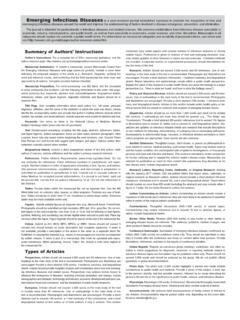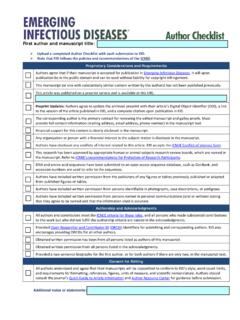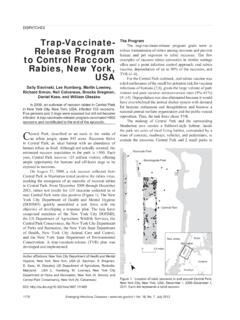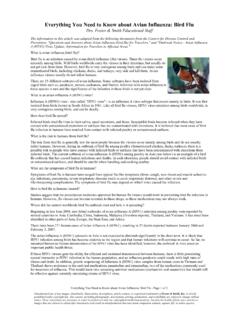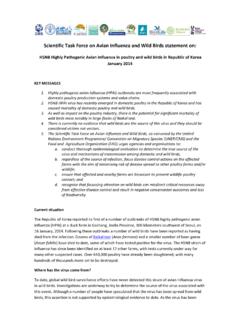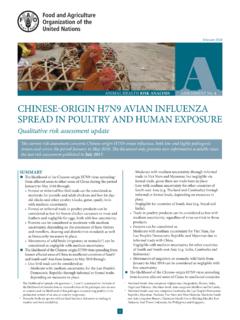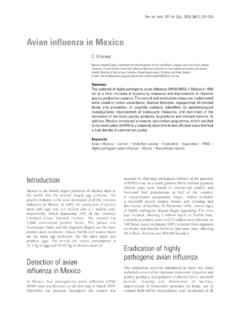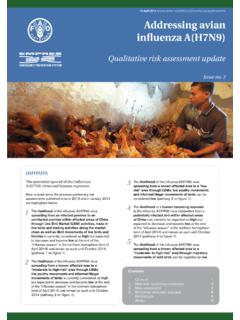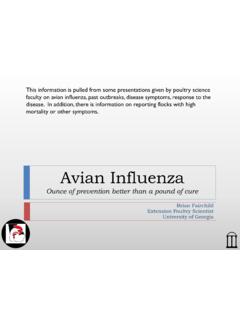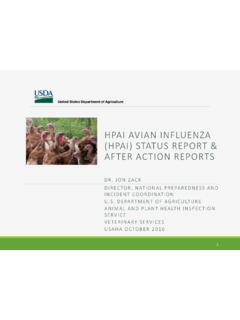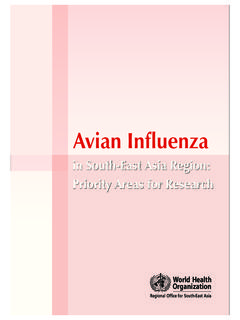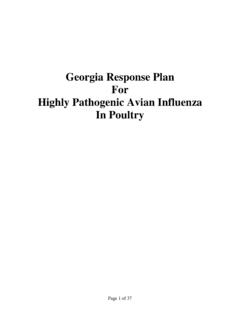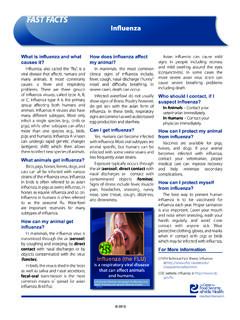Transcription of Monitoring Avian Influenza A(H7N9) Virus through National ...
1 Monitoring Avian Influenza A(H7N9) Virus through National Influenza -like Illness Surveillance, ChinaCuiling Xu, Fiona Havers, Lijie Wang, Tao Chen, Jinghong Shi, Dayan Wang, Jing Yang, Lei Yang, Marc-Alain Widdowson, and Yuelong ShuIn China during March 4 April 28, 2013, Avian Influenza A(H7N9) Virus testing was performed on 20,739 specimens from patients with Influenza -like illness in 10 provinces with confirmed human cases: 6 ( ) were positive, and in-creased numbers of unsubtypeable Influenza -positive spec-imens were not seen.
2 Careful Monitoring and rapid charac-terization of Influenza A(H7N9) and other Influenza viruses remain of April 28, 2013, a total of 125 cases of Avian influ-enza A(H7N9) Virus infection and 24 related deaths were confirmed in humans in 8 provinces and 2 munici-palities (hereafter called affected provinces/municipalities) of mainland China (1). The median age of patients was 63 years; most were male and had a history of exposure to live poultry (2). The first confirmed case was reported on March 31.
3 On April 3, the Chinese Center for Disease Control and Prevention (China CDC) distributed primers and probes specific for Avian Influenza A(H7N9) Virus to all National Influenza surveillance network laboratories in China. To better understand the epidemiology, geographic spread, and clinical spectrum of this Virus in China, we de-scribe the Chinese National Influenza -Like Illness Surveil-lance Network (CNISN) and analyze data collected since March 4, StudyThe CNISN includes 554 sentinel hospitals conduct-ing surveillance for Influenza -like illness (ILI; hereafter called sentinel hospitals) and 408 network laboratories in all 31 provinces of China (Figure 1).
4 On a weekly basis, sentinel hospitals report the number of outpatient visits, by age group, for ILI and the total number of outpatients. Each week, 5 15 nasopharyngeal swab samples are collected from a convenience sample of patients who visit sentinel hospitals within 3 days of ILI onset. ILI is defined as tem-perature >38 C and cough or sore throat. Demographic and epidemiologic data, including age, sex, date of illness on-set, and occupation, are also collected. Patient specimens are tested by real-time reverse transcription PCR or Virus isolation in the affiliated April 3, 2013, to enhance surveillance for Influenza A(H7N9) Virus , all network laboratories were required to increase the number of specimens to a minimum of 15/week and to test all specimens collected since March 4, 2013, for Influenza A(H7N9) Virus by real-time reverse transcription PCR as described (3,4).
5 We analyzed data collected by CNISN during March 4 April 28. Population data by age group were provided by the National Bureau of Statistics of March 4 April 28, CNISN tested 46,807 na-sopharyngeal swab samples from 554 sentinel hospitals throughout mainland China. Samples included 20,739 specimens from patients with ILI at 141 sentinel hospitals in 10 affected provinces/municipalities: Anhui, Jiangsu, Zhejiang, Shandong, Henan, Fujian, Jiangxi, and Hu-nan Provinces and Shanghai and Beijing Municipalities (Tables 1, 2).
6 The median number of specimens collected each week from affected provinces/municipalities was 244 (range 72 792). Of the 20,739 samples from patients with ILI, 10,035 ( ) were from persons 0 14 years of age, 9,319 ( ) were from persons 15 59 years of age, and 1,385 ( ) were from persons >60 years of age. The age distribution of ILI cases in the 10 affected prov-inces/municipalities was substantially different from that in the overall population; persons 25 59 years of age had a lower proportion of ILI than would be expected had ILI distribution mirrored the age distribution of the population.
7 (online Technical Appendix Figure 1, ). In the affected provinces/municipalities, the number of specimens tested increased from a mean of 2,643 during the week starting April 1 to a peak of 3,259 during the week starting April 9; the increase was highest among persons 15 24 and 25 59 years of age (online Technical Appendix Figure 2).During April 1 28, the percentage of visits for ILI increased in 5 of the 7 affected southern provinces and 2 of 3 affected northern provinces/municipalities (Figure 2).
8 However, during the same period, the proportion of speci-mens positive for Influenza decreased in the affected prov- the 10 affected provinces/municipalities, 5 re-ported >1 ILI patient with test results positive for influ-enza A(H7N9) Virus . The percentage of specimens positive Emerging Infectious Diseases Vol. 19, No. 8, August 2013 1289 Author affiliations: Chinese Center for Disease Control and Preven-tion, Beijing, China (C. Xu, L. Wang, T. Chen, J. Shi, D. Wang, J. Yang, L. Yang, Y. Shu); and US Centers for Disease Control and Prevention, Atlanta, Georgia, USA.
9 (F. Havers, Widdowson)DOI: Influenza A(H7N9) Virus , by province/municipality, ranged from 0 to (Table 2). We detected Influenza A(H7N9) Virus in samples from 6 ( ) of the 20,739 patients with ILI; these cases were then reported as con-firmed to the local CDCs and China CDC. No unsub-typeable Influenza samples were reported in the affected provinces/municipalities during the study period (online Technical Appendix Table).Epidemiologic investigations found that 2 of the 6 patients with Influenza A(H7N9) infection had not been hospitalized, and the other 4 had been hospitalized for pneumonia complications.
10 The 2 patients who were not hospitalized were 2 and 4 years of age. Of the 4 hospital-ized patients, 3 were 25 59 years of age, and 1 was 69 years of age. Four of the patients had a history of contact with live chickens or visiting a live poultry the Avian Influenza A(H7N9) Virus outbreak was identified in China, CNISN increased sampling and testing of ILI case-patients. CNISN has tested >46,807 specimens from all provinces, including 20,739 specimens from af-fected provinces/municipalities.
